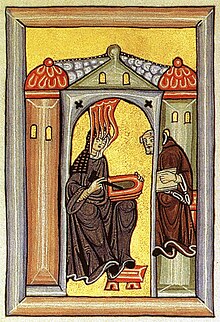ST.HILDEGRAD DAY SEPTEMBER 17
INVENTED NEW LANGUAGE LATIN + GERMAN
Hildegard of Bingen, O.S.B. (German: Hildegard von Bingen; Latin: Hildegardis Bingensis; 1098 – 17 September 1179), also known as Saint Hildegard and Sibyl of the Rhine, was a German Benedictine abbess, writer, composer, philosopher, Christian mystic, visionary, and polymath.[1] She is considered to be the founder of scientific natural history in Germany.[2]
| St. Hildegard of Bingen, O.S.B. | |
|---|---|

Illumination from the Liber Scivias showing Hildegard receiving a vision and dictating to her scribe and secretary
| |
| Doctor of the Church, Sibyl of the Rhine | |
| Born | 1098 Bermersheim vor der Höhe,County Palatine of the Rhine,Holy Roman Empire |
| Died | 17 September 1179 (aged 81) Bingen am Rhein, County Palatine of the Rhine, Holy Roman Empire |
| Venerated in | Roman Catholic Church (Order of St. Benedict) Anglican Communion Lutheranism |
| Canonized | 10 May 2012 (equivalent canonization), Vatican City by Pope Benedict XVI |
| Major shrine | Eibingen Abbey Germany |
| Feast | 17 September |
Hildegard was elected magistra by her fellow nuns in 1136; she founded the monasteries of Rupertsberg in 1150 and Eibingen in 1165. One of her works as a composer, the Ordo Virtutum, is an early example of liturgical drama and arguably the oldest surviving morality play.[3] She wrote theological, botanical, and medicinal texts, as well as letters, liturgical songs, and poems, while supervising miniature illuminations in the Rupertsberg manuscript of her first work, Scivias.[4] She is also noted for the invention of a constructed language known as Lingua Ignota.
Although the history of her formal consideration is complicated, she has been recognized as a saint by branches of the Roman Catholic Church for centuries. On 7 October 2012, Pope Benedict XVI named her a Doctor of the Church
Lingua Ignota and invented alphabet[edit]
Alphabet by Hildegard von Bingen, Litterae ignotae, which she used for her language Lingua Ignota
Hildegard also invented an alternative alphabet. The text of her writing and compositions reveals Hildegard's use of this form of modified medieval Latin, encompassing many invented, conflated and abridged words.[9] Because of her inventions of words for her lyrics and use of a constructed script, many conlangers look upon her as a medieval precursor.[63] Scholars believe that Hildegard used her Lingua Ignota to increase solidarity among her nuns.[64

No comments:
Post a Comment